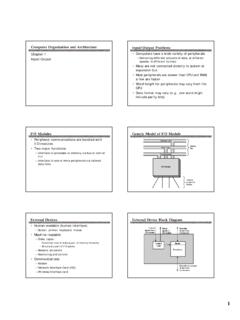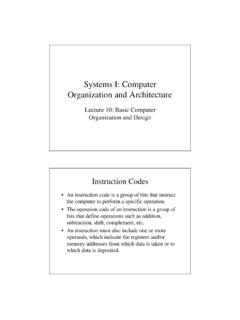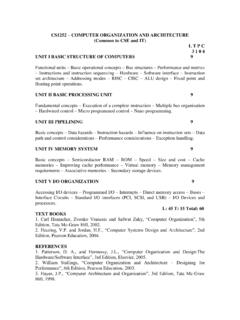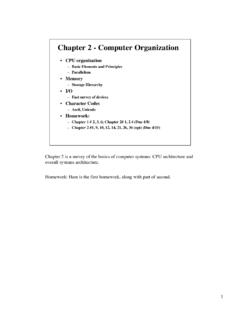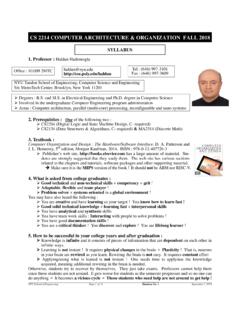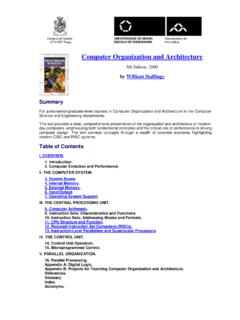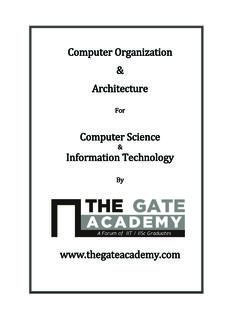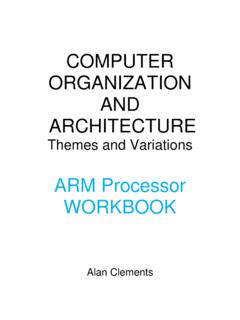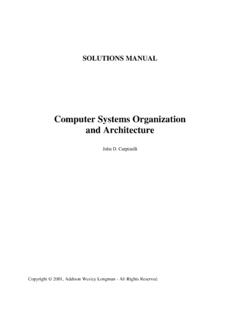Transcription of Computer Organization and Architecture …
1 1 Chapter 4 Cache MemoryComputer Organization and ArchitectureNote: Appendix 4A will not be covered in class, but the material is interesting reading and may be used in some homework of Memory SystemsLocation CPU Registers and control unit memory Internal Main memory and cache External Storage devices (paper tape, cards, tapes, discs, flash cards, etc.)Capacity Word size The natural unit of organisation Typically number of bits used to represent an integer in the processor Number of words Most memory sizes are now expressed in bytes Most modern processors have byte-addressable memory but some have word addressable memory Memory capacity for A address lines is 2 Aaddressable unitsUnit of Transfer Internal Usually governed by data bus width External Usually a block which is much larger than a word (typical disk 512 -4096 bytes)
2 Addressable unit Smallest location which can be uniquely addressed Some systems have only word addressable memory while many have byte addressable memory A block or even cluster of blocks on most disksAccess Methods (1) Sequential Start at the beginning and read through in order Access time depends on location of data and previous location tape Direct Individual blocks have unique address Access is by jumping to vicinity plus sequential search Access time depends on location and previous location disk2 Access Methods (2) Random Individual addresses identify locations exactly Access time is independent of location or previous access RAM Associative Data is located by a comparison with contents of a portion of the store Access time is independent of location or previous access All memory is checked simultaneously.
3 Access time is constant cachePerformance From user s perspective the most important characteristics of memory are capacity and performance Three performance parameters: Access time Cycle Time Transfer Rate Access time (latency) For RAM access time is the time between presenting an address to memory and getting the data on the bus For other memories the largest component is positioning the read/write mechanismPerformance Cycle Time Primarily applied to RAM; access time + additional time before a second access can start Function of memory components and system bus, not the processor Transfer Rate the rate at which data can be transferred into or out of a memory unit For RAM TR = 1 / (cycle time)Transfer rate for other memories Tn= Ta+ (n/r) where Tn=Average time to read or write N bits Ta =Average access time n = number of bits r = transfer rate in bits / secondPhysical Types of Memory Semiconductor RAM (volatile or non-volatile)
4 Magnetic Surface Memory Disk & Tape Optical CD & DVD Others Magneto-optical Bubble HologramPhysical Characteristics Volatility Does the memory retain data in the absence of electrical power? Decay Ranges from tiny fractions of a second (volatile DRAM) to many years (CDs, DVDs) Erasable Can the memory be rewritten? If so, how fast? How many erase cycles can occur? Power consumption3 Organization Physical arrangement of bits into words Not always obvious, , interleaved memory (examples later)Memory Hierarchy For any memory: How fast? How much? How expensive? Faster memory => greater cost per bit Greater capacity => smaller cost / bit Greater capacity => slower access Going down the hierarchy.
5 Decreasing cost / bit Increasing capacity Increasing access time Decreasing frequency of access by processorMemory Hierarchy -DiagramMemory Hierarchy Registers In CPU Internal or Main memory May include one or more levels of cache RAM External memory Backing storeHierarchy List Registers L1 Cache L2 Cache Main memory Disk cache Magnetic Disk Optical Tape (and we could mention punch cards, etc at the very bottom)Locality of Reference Two or more levels of memory can be used to produce average access time approaching the highest level The reason that this works well is called locality of reference In practice memory references (both instructions and data) tend to cluster Instructions: iterative loops and repetitive subroutine calls Data: tables, arrays, etc.
6 Memory references cluster in short run4 Cache A small amount of fast memory that sits between normal main memory and CPU May be located on CPU chip or module Intended to allow access speed approaching register speed When processor attempts to read a word from memory, cache is checked firstCache Memory Principles If data sought is not present in cache, a block of memory of fixed size is read into the cache Locality of reference makes it likely that other words in the same block will be accessed soonCache and Main MemoryA Simple two-level cache Level 1: 1000 words, s Level 2: 100,000 words s If word in L1 processor has direct access else word copied from L2 into L1 Av Access Time as function of hit ratio H:H * s + (1-H)* s With H near 1 access time approaches sTwo-level cache performanceTwo-level disk access Principles of two-level memories can be applied to disk as well as RAM A portion of main memory can be used as a disk cache Allows disk writes to be clustered.
7 Largest component of disk access time is seek time Dirty (modified) datamay be requested by the program before it is even written back to disk5 Cache/Main Memory StructureCache view of memory N address lines => 2nwords of memory Cache stores fixed length blocks of K words Cache views memory as an array of M blocks where M = 2n/K A block of memory in cache is referred to as a line. K is the line size Cache size of C blocks where C < M (considerably) Each line includes a tagthat identifies the block being stored Tag is usually upper portion of memory addressCache operation overview CPU requests contents of memory location Check cache for this data If present, get from cache (fast)
8 If not present, read required block from main memory to cache Then deliver from cache to CPU Cache includes tags to identify which block of main memory is in each cache slotCache Read Operation -FlowchartTypical Cache OrganizationCache Organization The preceding diagram illustrates a shared connection between the processor, the cache and the system bus (look-aside cache) Another way to organize this system is to interpose the cache between the processor and the system bus for all lines (look-through cache)6 Elements of Cache Design Addresses (logical or physical) Size Mapping Function (direct, assoociative, set associative) Replacement Algorithm (LRU, LFU, FIFO, random) Write Policy (write through, write back, write once) Line Size Number of Caches (how many levels, unified or split)Note that cache design for High Performance Computing (HPC) is very different from cache design for other computersSome HPC applications perform poorly with typical cache designsCache Size doesmatter Cost More cache is expensive Would like cost/bit to approach cost of main memory Speed But we want speed to approach cache speed for all memory access More cache is faster (up to a point)
9 Checking cache for data takes time Larger caches are slower to operateComparison of Cache SizesVirtual Memory Almost all modern processors support virtual memory(Ch 8) Virtual memory allows a program to treat its memory space as single contiguous block that may be considerably larger than main memory A memory management unit takes care of the mapping between virtual and physical addressesLogical Cache A logical (virtual) cache stores virtual addresses rather than physical addresses Processor addresses cache directly without going through MMU Obvious advantage is that addresses do not have to be translated by the MMU A not-so-obvious disadvantage is that all processes have the same virtual address space a block of memory starting at 0 The same virtual address in two processes usually refers to different physical addresses So either flush cache with every context switch or add extra bitsLogical and Physical Cache7 Look-aside and Look-through Look-aside cache is parallel with main memory Cache and main memory both see the bus cycle Cache hit.
10 Processor loaded from cache, bus cycle terminates Cache miss: processor AND cache loaded from memory in parallel Pro: less expensive, better response to cache miss Con: Processor cannot access cache while another bus master accesses memoryLook-through cache Cache checked first when processor requests data from memory Hit: data loaded from cache Miss: cache loaded from memory, then processor loaded from cache Pro: Processor can run on cache while another bus master uses the bus Con: More expensive than look-aside, cache misses slowerMapping Function There are fewer cache lines than memory blocks so we need An algorithm for mapping memory into cache lines A means to determine which memory block is in which cache line Example elements: Cache of 64kByte Cache block of 4 bytes cache is 16k (214) lines of 4 bytes 16 MBytes main memory 24 bit address (224=16M)(note.)
